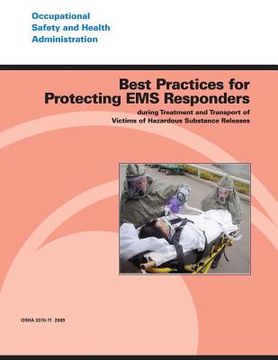Share
Best Practices for Protecting EMS Responders During Treatment and Transport of Victims of Hazardous Substance Releases (in English)
Occupational Safety and Administration
(Author)
·
Createspace Independent Publishing Platform
· Paperback
Best Practices for Protecting EMS Responders During Treatment and Transport of Victims of Hazardous Substance Releases (in English) - Administration, Occupational Safety and ; Labor, U. S. Department of
$ 13.11
$ 16.39
You save: $ 3.28
Choose the list to add your product or create one New List
✓ Product added successfully to the Wishlist.
Go to My WishlistsIt will be shipped from our warehouse between
Thursday, July 04 and
Friday, July 05.
You will receive it anywhere in United States between 1 and 3 business days after shipment.
Synopsis "Best Practices for Protecting EMS Responders During Treatment and Transport of Victims of Hazardous Substance Releases (in English)"
In 2005, OSHA published the Best Practices for Hospital-Based First Receivers guide that provided guidance for those healthcare facilities that receive and treat victims of hazardous substance releases. At the request of stakeholders that participated in the development of that guide, OSHA has developed a similar guide for emergency medical service (EMS) responders who provide medical assistance during an incident involving a hazardous substance release. This guide is intended for employers of EMS responders and discusses the measures these employers need to take to protect their EMS responders from becoming additional victims while on the front line of medical response. EMS responders are broadly defined here as the individuals who provide pre-hospital emergency medical care and patient transportation. Some EMS responders are also assigned duties that support patient care, including patient decontamination. For the purpose of this guide, the term EMS responder refers to all levels of emergency medical personnel involved in incident response (e.g., emergency medical technicians [EMTs], paramedics, and others who perform similar duties). While many EMS responders are cross-trained (e.g., EMT and firefighter), this guide applies to these workers only when they are functioning as EMS responders. Preplanning helps employers ensure that their workers have adequate training and personal protective equipment (PPE) for the incidents in which the workers are expected to participate. Critical steps for the employer involve determining the EMS responder's expected role in a reasonably anticipated worst-case scenario, identifying the hazards that are associated with the EMS responder's assigned duties, and developing an emergency response plan (ERP) that spells out how the EMS responder will be prepared (through training and PPE) to safely fulfill those duties (OSHA Instruction CPL-02-02-073, Emergency Responses to Hazardous Substance Releases, Aug. 27, 2007).
- 0% (0)
- 0% (0)
- 0% (0)
- 0% (0)
- 0% (0)
All books in our catalog are Original.
The book is written in English.
The binding of this edition is Paperback.
✓ Producto agregado correctamente al carro, Ir a Pagar.

